AccessComputing News - December 2022

Below are the articles of the AccessComputing News - December 2022 newsletter. These articles can also be seen all on one page at the Full Newsletter option.
2022 AccessComputing Capacity Building Award Goes to Shiri Azenkot and Larry Goldberg
The winners of the 2022 AccessComputing Capacity Building Award goes to Shiri Azenkot and Larry Goldberg for their creation of XR Access, a research consortium centered at Cornell Tech in New York City. XR Access, founded in 2019, has the goal of leading and fostering a community that engages, connects, and influences the field of XR (virtual and augmented reality technology) to ensure that XR is inclusive of all, regardless of abilities. Since 2020, it has held an annual symposium that brings together researchers, practitioners, and disability advocates to share the latest advances in making XR accessible. XR Access is an important organization because it is starting early in the development of XR technology. In this way XR technology solutions are more likely to be accessible than if accessibility was an afterthought.
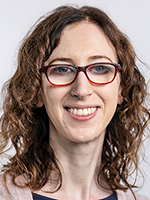
Azenkot is an associate professor in information science in the Jacobs Technion-Cornell Institute at both Cornell Tech and Technion, Israel Institute of Technology. She is a well-known accessibility researcher with a focus on people with visual impairments, which includes people who are blind and people with low vision, a large and understudied population. When she was a graduate student at the University of Washington, she was an AccessComputing Team member. As a professor, she has hosted several AccessComputing Team members in summer undergraduate research internships.
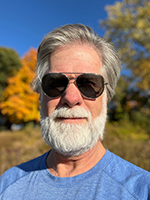
Goldberg recently retired from Yahoo! as the Head of Accessibility. He built his career in accessibility during his 28 years at WGBH in Boston, which was a leader in the development of captions for television. Goldberg continues to be active as an accessibility consultant and serves on the Board of Teach Access.
Congratulations to both Azenkot and Goldberg for all their hard work with XR Access and their inclusion endeavors throughout the years.
New AccessComputing Partners
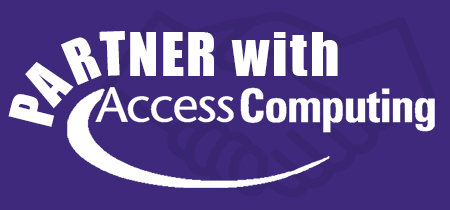
Since last spring, AccessComputing has welcomed several new partners to our project. AccessComputing partners are committed to increasing the participation of people with disabilities in computing education and careers. They take steps to make their departments or organizations inclusive and welcoming to people with disabilities. Our partners engage in a Community of Practice and monthly meetings focused on accessibility.
Our new partners over the past six months come both from institutions and companies:
- Centre College, Thomas Allen
- Open Education Research Lab, Samuel Abramovich and Rachel Bonnette
- Drake University, Meredith Moore
- University of Virginia, Siri Russell
- University of Texas at Austin, Earl Huff
- Grinnell College, Sam Rebelsky
- Florida Institute of Technology, Nasheen Nur
- ASRC Federal, Shavondalyn Givens and Spencer Broste
- Our Ability, John Robinson and Kartik Sawhney
- Scopes, Derrick Adam
To learn more about becoming an AccessComputing partner email accesscomp@uw.edu.
Recent Awards to AccessComputing Partners
We are excited that three AccessComputing Partners have recently been selected for significant awards.
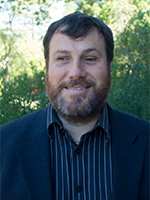
The University of Maine’s VEMI Lab, led by chief research scientist Nicholas Guidice, earned third place in the U.S. Department of Transportation’s Inclusive Design Challenge for its Autonomous Vehicle Assistant (AVA). The competition looked for “innovative design solutions to enable people with physical, sensory, and cognitive disabilities to use automated vehicles to access jobs, healthcare, and other critical destinations.”
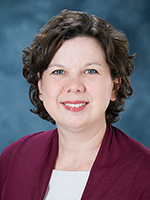
Sarah B. Lee, The University of Southern Mississippi, was awarded the (ISC)² Diversity Award, which “honors individuals who represent the core values of (ISC)² through significant contributions in driving a more diverse workforce in the cybersecurity community.” (ISC)² is a professional association for cybersecurity. Sarah is one of the cofounders of the Last Mile Fund, which provides financial support for low-income underrepresented students in computing to help them complete their degrees.
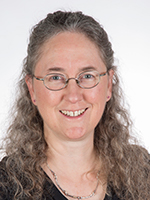
Susan Rodger, Duke University, was selected for the 2023 SIGCSE Award for Outstanding Contribution to Computer Science Education, which honors an individual or group in recognition of a significant contribution to computer science education. The award will be presented at SIGCSE in Toronto in March 2023.
AccessComputing Team Members Complete Their PhDs
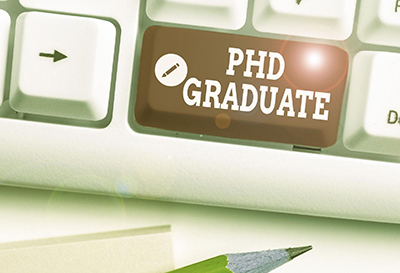
Multiple AccessComputing Team Members graduated with PhDs this year. Congratulations to them all. Below are the students who announced their graduation and let us know what the future holds:
- Heriberto Acosta Maestre received his Ph.D. in information systems from the College of Computing and Engineering at Nova Southeastern University. His dissertation titled "The Empirical Study of the Factors that Influence Threat Avoidance Behavior in Ransomware Security Incidents" focused on studying threat avoidance behavior in the context of ransomware security incidents among college students. He is interested in information security, human computing interactions, health data science, and data mining applications. Heriberto continues to work as the distributed learning program training administrator in the Puerto Rico National Guard. He volunteered at the Tapia 2022 conference as deputy chair of posters.
- Huy Từ defended their dissertation on the topic of "Reducing Effort of Labeling Software Engineering Data with Semi-supervised Learning" from North Carolina State University. Beside their PhD's dissertation topic, they are also invested in linguistic and machine learning fairness domains. Currently, Huy is following their passions in investigating and mitigating biases in decision-making at one of the big five tech companies.
- Carl C Haynes-Magyar received his Ph.D. in information from the University of Michigan School of Information in the winter semester of 2022. His dissertation is titled "On Learning How to Program via an Interactive eBook with Parsons Problems." Carl's research broadly focuses on how people learn and how people learn how to learn to design theory-based learning technologies for computing education that support symbiotic relationships between learners and artificial intelligence. In the fall of 2022, Carl began as a presidential postdoctoral fellow at the Human-Computer Interaction Institute at Carnegie Mellon University with Dr. Kenneth R. Koedinger.
- Shamma Nasrin received her Ph.D. in electrical and computer engineering from the University of Illinois Chicago. Some of her research interests include neuromorphic computing, deep learning neural networks, and low-power and high-performance in-memory processing systems.
- Andrea Lane received her Ph.D. in biostatistics in August 2022 from Emory University. Her dissertation is titled “Detecting Cell-type-specific Mediation Effects in DNA Methylation Data.” She is passionate about statistics/data science education and incorporating diversity, equity, and inclusion principles into statistics courses. She is now an assistant professor of the practice at Duke University in the master of interdisciplinary data science (MIDS) program.
- Dhruv Jain received his Ph.D. in computer science and engineering from the University of Washington in spring 2022. His dissertation is entitled “Sound Sensing and Feedback Techniques for Deaf and Hard of Hearing People.” He is now an assistant professor in computer science and engineering at the University of Michigan. His research intersects human-computer interaction (HCI) and applied machine learning (ML), with a focus on sound accessibility.
- Elba Garza received a Ph.D. in computer science from Texas A&M University. Her work focused on making hardware predictive structures and policies more resilient to evolving computing demands. Over the last few years, Elba has earned honors such as the 2020 IEEE Computer Society Lance Stafford Larson Student Award, named a 2020 Rising Star in EECS, and was a 2021 Google Scholar. She is currently an assistant teaching professor at the Paul G. Allen School of Computer Science & Engineering at the University of Washington.
Congratulations to all those who graduated and are moving forward to the next steps in their careers.
Students Attend Tapia and Grace Hopper Conferences
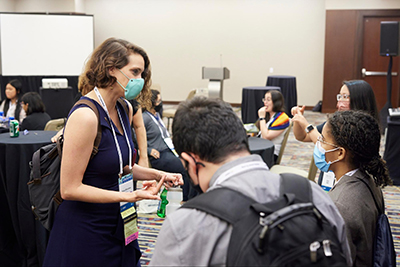
AccessComputing Co-PI Stacy Branham talking to participants at Tapia. Photo courtesy of Tapia.
Twenty-three AccessComputing team members kicked off the start of this academic year in true celebratory fashion; they received full or partial funding to attend one of two annual fall conferences celebrating diversity in computing. Early in September, 13 AccessComputing Team Members traveled to Washington DC to participate in the Richard Tapia Celebration of Diversity in Computing Conference and then in mid-September, another 10 Team Members received support for virtual registrations to participate in the Grace Hopper Celebration of Women in Computing, held in Orlando.
AccessComputing was well represented at the Tapia Celebration in particular, as several principal investigators (PIs) joined students at the event. Among these PIs was Dr. Stacey Branham, faculty member at the University of California, Irvine (UCI). Dr. Branham was featured as plenary speaker and gave a powerful talk, sharing her story as a woman with a disability and her path to becoming a professor of informatics at UCI. Several AccessComputing team members commented on the power and impact of Dr. Branham’s speech and identified it as one of the high points of the conference. You can watch Dr. Branham’s speech on the Tapia Facebook Page.
Avi Knotts, an undergrad from Temple University, wished there had been more Black people in attendance and that more of the speakers were people of color; however, she felt that the “Black Women’s Voices, Leadership and Vision for K16 Computer Science Education” panel discussion was a highlight for her:
“That discussion brought me to tears because everything that was said was so true and really hit home. It was great to hear that the experiences I’ve faced are universal and that a solution needs to be found. It was also very nice to see that people who did not share those similar experiences were enlightened and very intrigued by the stories of the panelists.”
Naba Rizvi, a grad student from University of California, San Diego noted that she really enjoyed the various disability-related sessions, and particularly the Birds of a Feather conversations, which allowed her to meet with others who share her passion for disability inclusion. Naba also thought there was room for additional participation by speakers, attendees, and other individuals who experience psychosis:
“I wasn't able to find any talks or resources on [psychosis], which is sad because they're an underserved, underrepresented, misunderstood, and widely stigmatized community. However, I understand the underrepresentation of stigmatized mental illnesses may just be a reflection of our society/industry as a whole and not necessarily exclusive to Tapia.”
Team Members also shared some perspectives on Grace Hopper (GHC) as well. Zhuomin Li, a grad student at Washington University in St. Louis attended Tapia and GHC, even working a booth for Washington University at the latter. Zhuomin commented that GHC is larger than Tapia, and at GHC he had a chance to talk to a lot of women about grad school. Other GHC attendees commented on how empowering it was to be in a space filled with women in computing. One attendee noted that she’s experienced challenges with the interviewing process and really valued a session from a corporate interviewer, with tips on how to approach interviewing and discussion on accommodations for the interview process.
Conference attendance can be an invaluable experience for AccessComputing Team Members. Dr. Raja Kushalnagar, AccessComputing PI from Gallaudet University, noted that one of his undergraduate students considered her experience at Tapia to be a real eye-opener when it came to graduate school admissions expectations, something she may not have realized if she’d not attended. Dr. Elaine Short, AccessComputing PI from Tufts University, was delighted at the opportunity to connect with students from other campuses and even had one Boston-area student she’d met in DC visit her on the Tufts campus a couple weeks after the conference.
While both Tapia and GHC are celebrations of diversity in computing, they’re also important opportunities for AccessComputing Team Members to network, learn, and explore their career and graduate school options.
Gallaudet’s New Master of Science in Accessible Human-Centered Computing
For students with disabilities, Gallaudet University has launched a new Master of Science in Accessible Human-Centered Computing (AHCC), designed for deaf, hard of hearing, and other students with disabilities who seek specialized academic training in designing, evaluating, and implementing effective evidence-based accessible design and evaluation strategies and messages to address the accessibility needs of diverse audiences.

Gallaudet University (GU) is a fully accessible environment offering a unique, American Sign Language and English learning environment for all faculty, students, and staff. Students are immersed in a language-rich learning environment; students and faculty communicate as directly as possible, modeling and building habits of academic discourse in ASL and English. In doing this we ensure our community will learn for the rest of their lives and careers through the lens of ASL and English bilingualism, diversity, equity, and inclusion.
AHCC students take classes with research and policy activities that leverage Gallaudet University’s unique expertise in accessible computing through a deaf and hard of hearing-centric lens. They gain practical hands-on experience in accessible design through both coursework and participating in ongoing accessible research and development projects run at Gallaudet University and its partners. Much of the instruction is interactive and includes the use of new and emerging accessible technologies, making students well-prepared to meet the organizational demands for accessible technology.

The program, led by Dr. Christian Vogler and me, Dr. Raja Kushalnagar, is structured in terms of cohorts with students progressing through the program as a group. This format not only ensures on-time program completion, but also maximizes interaction with faculty and fellow students and networking. Industry experts will offer support and advice, along with internship opportunities. As the first university-level program of its kind, this program is unique in offering both academic and hands-on training. The coursework and community collaboration activities also serve as an incubator for accessible research and policy.
As an AccessComputing Co-PI, I also focus on increasing the numbers of people with disabilities in the computing pipeline through community involvement. In addition, I bring consumers, industry, and policymakers together on accessibility issues with focus on deaf/hard of hearing perspectives and evidence-based research, and advocate for laws and regulations to incorporate accessible computing advances such as automatic captioning/subtitling. I have mentored over 100 undergraduates, including over 60 who are deaf or hard of hearing.
AccessComputing Employment Resources Page
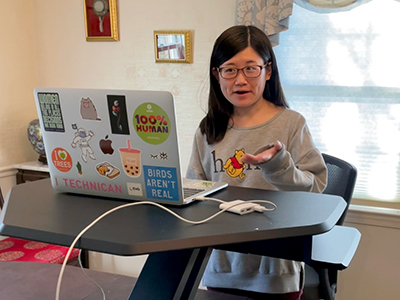
Have you checked out the recently updated AccessComputing Employment Resources page lately? Whether you’re still in the middle of your studies, getting ready to graduate, or currently job hunting, you should! We’ve been expanding and adding resources, and links are divided into sections, which are expanded and updated whenever we discover new resources.
The section on Disability- and Neurodiversity-Focused Employment Websites has been expanded significantly. Some of the sites focus exclusively on job listings for companies that are actively searching to diversify their employee base with individuals who have a disability of any type, while several of the sites specialize in autism and neurodiversity. Among the employment sites focusing on neurodiversity, there are several that specialize in providing mentoring for job seekers, and there are a few sites that offer support and training for companies seeking to hire employees with disabilities.
If you’re interested in or considering working overseas, there are two employment sites for that; they both include listings for jobs in the US, but also include job listings for Europe, Canada, South America, Australia, and India. A few of these employment sites also include internships, and many of them provide advice on conducting a job search. Every site on the AccessComputing resource list includes a brief blurb to indicate their particular focus or specialty.
Other sections on the Employment Resources page include a list of corporate-specific recruitment sites, such as Microsoft’s Neurodiversity Hiring Program, and a list of business tech companies that are particularly interested in hiring employees on the autism spectrum for work in fields like data analytics, software and application development and computer engineering. We recommend pursuing these resources; if you have others you would recommend, email us at accesscomputing@gmail.com.
Two New Releases of Free Accessibility Tools funded by AccessComputing
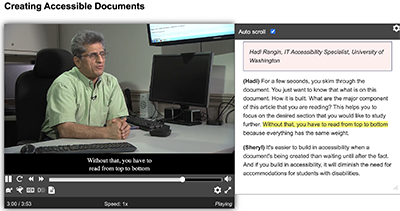
Able Player
In November 2022, Able Player 4.5 was released. Able Player is an online media player created with accessibility in mind. It’s the only media player that supports all five kinds of timed text tracks defined by the HTML specification (captions, subtitles, descriptions, chapters, and metadata). It also includes many additional features such as an interactive transcript, support for synchronized sign language in a pop-up video window, a fully accessible set of buttons and controls, and a highly customizable interface through the preferences menu.
One of the biggest changes in the new release is the improvement to Able Player’s support for audio description as a timed text track, read aloud by browsers using the Web Speech API. This feature had been added in an earlier version, but it now works more reliably across all browsers and platforms. Users can customize the voice, rate, pitch, and volume in the description preferences dialog, as well as choose whether to automatically pause the video while description is playing (i.e., “extended audio description”). Also, if users speed up or slow down the video using the “faster” or “slower” buttons, the rate of description now changes as well, and description is now paused if users pause the video or skip back or forward to a new time.
Other features in the new release include captioning for audio and new settings that give authors more control over the default state of their video. For example, authors can set the default state of “extended description” to “on” if they know that pausing during description will be desirable for their videos, such as if their videos do not offer enough quiet time for description to be voiced.
Able Player 4.5 also features two new translations of all player controls, prompts, and messages. With the new Danish and Portuguese translations, Able Player is now available in 19 languages.
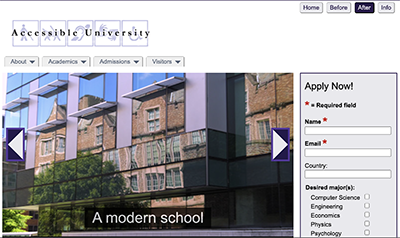
Accessible University
Also in November, a new version (version 3.0) of the Accessible University (AU) demo site was announced. AU is a fictional university, and the demo site features two versions of its home page, one “before” accessibility (a page with at least 22 known accessibility problems), and one “after” accessibility (the same page, with all 22 problems fixed). These pages are complemented by a third page that describes all the problems and their solutions.
The site was created as a tool for use in web accessibility trainings and workshops, although it can also be used independently as a self-training tool. The new version includes a variety of updates to reflect recent changes in accessibility coding techniques and best practices. Features that have been updated include the navigation menu, slideshow/carousel, data table, modal dialog, and online form with error validation. Also, video has been added to both the “before” and “after” pages. The “after” page uses the new version of Able Player for delivering accessible video with captions and audio description.
AU also includes a set of “before” and “after” Word, PDF, and PowerPoint files, designed to be used in trainings on document accessibility. All documents have been updated in the new release.
The new version of AU was unveiled in a half-day pre-conference workshop at the Accessing Higher Ground conference in Colorado on November 15. Attendees included people who were already using AU in their trainings and wanted to see what’s new, as well as people who had never seen the demo site before. The latter left the session excited with ideas for how they would utilize this tool on their own campuses. Attendees also provided excellent ideas for additional problems and solutions that could be added to the site, so we’re already eager to get started working on the next version.
Forthcoming Book: Teaching Accessible Computing
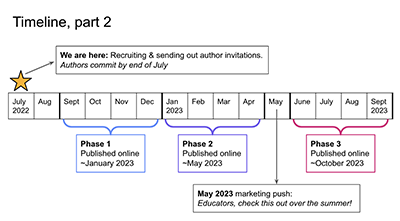
Writing for the forthcoming book, Teaching Accessible Computing, is underway. The editorial team, including Amy J. Ko, Richard Ladner, and doctoral student Alannah Oleson have structured the writing in three phases during the 2022-23 academic year. The first phase includes chapters on accessibility foundations, graphics, web development, computer vision, and software engineering, and will include a period of feedback. Phase 2 kicks off in January, and will include chapters on accessible teaching, introductory CS courses, data structures, and several other elective topics. The third and final phase will be next summer and end with typesetting and publishing. Overall, the book will have nearly 20 chapters by more than 20 authors from across academia and industry. We’re very excited to share the work after this year!
If you’re interested in contributing a chapter, or just participating in reviewing chapters prior to publishing the first edition, let us know in our online form.
Making Your Online Meeting or Presentation Accessible to Participants with Disabilities
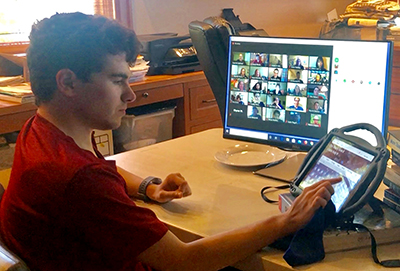
I doubt if anyone hosting a meeting or delivering a presentation intentionally excludes those who have a right to be there. However, every day, meeting hosts and presenters erect barriers to some people, including those with disabilities. Several examples follow:
- A person who is blind or connecting to a meeting by phone cannot effectively follow a presentation unless the presenter verbally describes critical content on slides.
- A person who is not blind but has a visual impairment may have difficulty reading content on a slide if the text is presented in a small font that is not sans serif on a background that is cluttered.
- An individual who is an English language learner or is deaf or hard of hearing may require captioning or a sign language interpreter.
- A person who needs more time to process the content will be disadvantaged unless a video recording is available.
- A person who is blind and using a screen reader to read aloud content in digital documents, slides, and websites will not be able to access information unless the materials are created in a text-based format that is structured to work well with their technology.
- An individual with a reading-related disability and using text-to-speech software to read aloud content presented in written materials will be disadvantaged in reading them if they are not in a text-based format.
Addressing these issues can help meeting hosts and presenters get started in making events welcoming and accessible to all participants. But this list is just a start.
For more information about hosting accessible and inclusive online and on-site meetings, presentations, and other events, consult our Knowledge Base article How can conferences, meetings, presentations, and other events be made accessible? There you will find a summary of basic considerations and links to useful resources with technical details and more suggestions. If you have recommendations for other resources to add to this list, share them at accesscomp@uw.edu. Also, search the Knowledge Base for other articles—questions and answers, case studies, and promising practices—related to the full inclusion of people with disabilities in academic, employment, and other engagements.
Zoom Announces New Features in Support of Sign Language
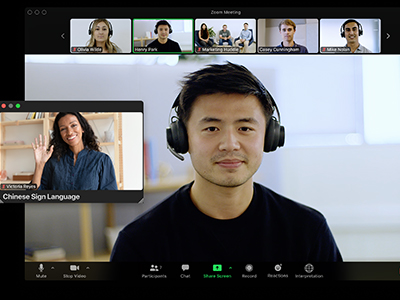
In October 2022, Zoom announced a new dedicated channel for sign language interpreters. The new feature allows one or more participants in a Zoom meeting to be assigned a role of “Interpreter” by the host, and assigned a specific language, such as “American Sign Language.”
Once interpreters are assigned, all meeting participants are notified that sign language interpretation is available, and an “Interpretation” button is added to the control bar at the bottom of the Zoom screen. If participants click this button, they’re presented with a choice of available languages. After selecting their preferred language, an interpreter window appears. It’s separate from the main Zoom window, so it can be resized and repositioned independently of the Zoom interface. If there are multiple interpreters for a given language, they share the same interpreter window but only one interpreter is shown at a time. They can hand-off to each other by toggling their video on and off.
This new feature offers an alternative to interpreters being regular participants, whose videos can be moved to the forefront by “pinning” (by individual users to customize their own view) or “spotlighting” (by the meeting host, for all users). This original model is delicate, as participants’ windows within Zoom share space with all the other Zoom features, such as the speakers’ video windows and shared screen. The new feature eliminates all confines and allows the interpreter to be anywhere on the screen, at any size.
Documentation from Zoom about these features is available for different audiences. Meeting owners and hosts should visit Managing Sign Language Interpretation. Participants can visit Viewing Sign Language Interpretation.
AccessComputing staff has been actively testing this new feature and providing ongoing feedback to Zoom’s accessibility team. There are a few known limitations. For example, as of November 2022, the interpreter window is not captured when the meeting is recorded. This limitation is expected to be addressed for cloud recordings in an upcoming release. A second problem is that the interpreter channel only works in the main room, not in breakout rooms. Interpreters can be assigned to breakout rooms, but in the breakout room they become regular participants again, so participants who need their services will need to fall back to the old way of doing things (e.g., pinning and spotlighting), until they return to the main room. A third problem is that interpreters by default do not have the ability to unmute themselves so they can speak on behalf of a participant. The host must change a setting for each interpreter to allow them to speak, which is burdensome for the host and adds an extra layer where things can go wrong.
If you have feedback you’d like to share with Zoom about their accessibility, send it to tft@uw.edu, and we will relay your feedback to the Zoom accessibility team.
Inclusive Coding Festival 2022
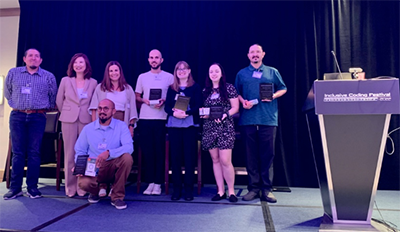
AccessComputing co-sponsored the Inclusive Coding Festival 2022, which took place on October 22 in Orange County, CA. It was a one-day conference that featured two keynote speeches: “Power of Diversity in AI” and “How People with Disability Elevate Computing,” a panel titled “Navigating Neurodiversity in Tech Industry,” and coding project presentations by neurodivergent students.
In the morning, AccessComputing co-PI Dr. Stacy Branham (University of California, Irvine) and Maria Alvarez (vice president of Experimentation Platform, AI Platform group, Microsoft) delivered inspiring keynote speeches and answered questions from the audience, while reflecting upon the journey of inclusion in computing education and industry. After that, a Tech Career Panel for neurodivergent students was presented. Panelists included senior leaders from Microsoft, SAP, and CAI Neurodiverse Solutions. They spoke about the Neurodiversity Hiring and Autism at Work programs at tech companies and services that neurodivergent talents can leverage. Some panelists were neurodivergent themselves and shared their own stories and experiences. Attendees found the panel very informative and encouraging.
Over summer 2022, the Inclusive Coding Festival hosted a pre-festival six week project event, matching 21 neurodivergent college students from 14 universities with volunteer mentors from tech companies. Students worked for these six weeks on projects in artificial intelligence, cloud, or game development with remote support from their project mentors. In the afternoon of October 22, five finalist projects were presented and prizes were awarded. After the college project competition, 12 K-12 students also showcased coding projects with at least one neurodivergent student in each team. There were 99 registered attendees on that day, which included IT employers, students both with disabilities and without, and families.
Inclusive Coding Festival 2022 was organized by a partner of AccessComputing, Code the Spectrum, which is a non-profit organization aiming to help build IT education and career pathways for neurodivergent students.
New Law Ensures Equivalent Access to Digital Tools for All of Maryland’s K-12 Students
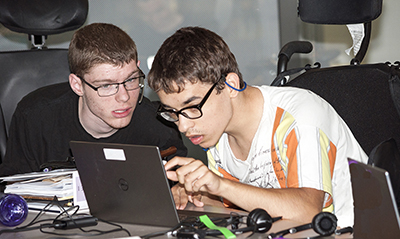
When Maryland’s 900,000 K-12 public school students hung up their backpacks in March 2020, where most remained for the next 18 months, the locus of teaching and learning shifted to Chromebooks and Zoom classrooms. The 24 school systems across Maryland state moved massive amounts of technology and Internet hotspots into students’ homes to facilitate access and ramped up their purchases of subscriptions and licenses for e-book repositories, math portals, digital science and social studies content, and more. But some of these digital tools did not meet basic accessibility standards, leaving students with visual impairments and other disabilities behind as their classmates and teachers scrambled to continue progressing in the required curriculum. When most students returned to school buildings in fall 2021, many digital tools became embedded in the curriculum, broadening the impact of inaccessibility.
The problem posed by inaccessible digital instructional tools was not created by the pandemic and school building closures, but the experiences of the past two years highlighted the issues faced by many students with disabilities and sharpened the focus of advocates and legislators in the Maryland General Assembly. In 2021, a first attempt to tackle this issue legislatively failed, but in the 2022 legislative session Senator Craig Zucker, who represents District 14 in Montgomery County, introduced SB617 The Equivalent and Nonvisual Access Accountability Act for K-12 Education, which passed in both houses in the Maryland legislature and was subsequently signed into law by Governor Larry Hogan. It went into effect July 1, 2022, with full implementation of all provisions required by October 2024.
Dr. Jonathan Lazar, AccessComputing partner, director of the Trace R&D Center, and professor in the UMD iSchool, worked closely with disability advocacy groups—including the National Federation for the Blind of Maryland (NFB of MD)—and legislators to craft the bill and testified in support of the measure. Dr. Lazar describes the new statute as both a civil rights law and a cost savings law. First, it requires that Maryland’s school systems procure only accessible digital tools for instructional purposes, ensuring that all students including students with disabilities have equivalent access to the tools provided to advance their education. Second, the law shifts the liability risk for inaccessibility from the school systems to the vendors of digital tools by including an indemnification clause. This means that companies cannot simply claim that their technology is accessible, but instead are fully accountable for these claims, including assuming responsibility for remediation if necessary as well as any liability for inaccessibility.
As Dr. Lazar explained in his testimony before the Maryland Senate Education, Health, and Environmental Affairs Committee: “When a county Board of Education acquires digital technology or content and later determines that it is inaccessible, it often requires extra expenses to remediate the technology, as well as a time delay in access for students with disabilities. But, the Board of Education should have never procured the technology in the first place, if the technology was not accessible. By having formal processes in place, the cost, risk, and responsibility are transferred to the vendor, rather than the county Boards of Education.”
Foundationally, the law rests on the philosophical underpinnings of Section 508 of the Rehabilitation Act of 1973 which requires that when federal government agencies develop, procure, or maintain information and communication technology (ICT), it is accessible to people with disabilities. To facilitate this requirement, Voluntary Product Accessibility Templates, or VPATs, are created by vendors. These documents are supposed to explain how ICT products such as software, hardware, electronic content, and support documentation meet 508 Standards for IT accessibility. By tying accessibility to procurement, government entities and industry share the responsibility and commitment to ensuring equal access to ICT for all users, including users with disabilities.
The new Maryland law is part of a nationwide effort to chip away at the inaccessibility too often faced by blind students and other students with disabilities; similar laws have been passed recently in New Jersey and Illinois. Longtime advocate for the blind and former president of the NFB of MB Sharon Maneki noted that these laws are part of a long-term approach to securing rights by providing a well-defined procurement process and mechanisms for accountability to give advocates and families opportunities to see what the school systems are purchasing and whether the process as outlined in the law is working. No law is perfect, but legislation, said Maneki, as she reflected on this victory, “is the art of the possible.” Maneki also remarked on the importance of having allies like Dr. Lazar become involved in the process: “Jonathan is a big asset as an expert in accessibility who can help us look at and shape the language of the law.”
Implementation of the new Maryland law faces some challenges. Currently, knowledge of the requirements within the 24 state school systems may be limited, and to be successful districts will need to ramp up accessibility expertise within the procurement process for the interpretation of VPAT documents. Transparency is a critical component of the law; beginning in October 2023 each local school system will be required to report on the accessibility of their digital tools. These reports will be compiled and made public as well as reported to the governor and the General Assembly.
While this law represents a significant step forward for digital accessibility within Maryland’s K-12 schools, there is always room for growth. The newly passed law does not ensure that teachers and staff with disabilities encounter only accessible technology in their work; administrative systems purchased by school districts do not have to meet this requirement. Further, even for instructional digital tools, the law allows districts to purchase inaccessible tools if the tool has “pedagogical value” and there is no equivalent accessible tool. Advocates hope, however, that as the provisions are integrated into the procurement process, vendors will recognize that accessibility makes their products more competitive, as well as being the right thing to do to ensure access for all students.
Changing procurement practices is one goal, but the larger mission is educating the wider community so that elected officials, administrators, teachers, and technology vendors all view digital accessibility as a civil rights issue for students with disabilities.
New AccessComputing Videos and Webinars

Videos
- Mentoring Students with Disabilities in Research Experiences
In this video, students with disabilities share their REU experiences and offer guidance to faculty about how they can mentor students with disabilities in research. - Creating Accessible Documents
Regardless of whether documents are created in Adobe PDF, Microsoft Word, or another format, there are right and wrong ways to create documents in order to ensure people with disabilities can access them. This video explains why and how to create electronic documents that are accessible to all users. - Supporting Computer Science Student Mental Health
Long hours, lacking a sense of belonging, and fear of failure are just some stressors that affect Computer Science students and professionals alike, leading to burnout, anxiety, and depression. - AccessADVANCE: Making STEM Departments More Inclusive of Faculty with Disabilities
In order to be inclusive and welcoming to faculty with disabilities universities and departments need to take proactive steps. Systematically reviewing and improving campus communications, worksites, meetings, technology, events, and services to make them more accessible and inclusive to faculty members with disabilities. - Women with Disabilities in Academic Careers
This video profiles women faculty members with disabilities sharing their experiences and perspectives that may be helpful for other women faculty members with disabilities and for academic departments and institutions that want to improve their practices with respect to fully including this marginalized group.
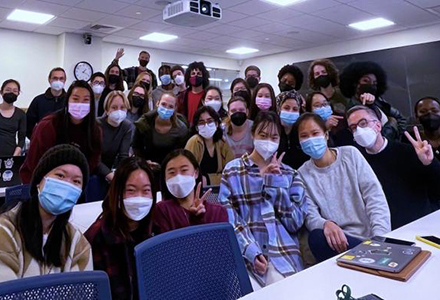
Webinar Recordings
- Including Students with Disabilities in CS Education
About 8.7 million PreK-12 students in the US have a disability and are served under the Individuals with Disabilities Act or under Section 504 of the Rehabilitation Act. These students have a number of barriers that prevent them from participating fully in CS education. In this webinar we discuss these barriers and how they can be removed to make CS education more accessible and welcoming to these students. - Partnering with AccessComputing to increase the participation of students with disabilities in computing at community and technical colleges
Learn more about strategies and resources to support students with disabilities in computing programs at community and technical colleges. There are funded opportunities to support your work in this area! - From Telecommute to Telecommunity: Pushing for institutional change
In 2022, Disabled faculty and students are requesting accommodations to remain off campus or to limit in-person exposure through continued access to remote or hybrid delivery of instruction. Many universities are denying these requests by calling them "unreasonable burdens" to the institution or citing institutional business interests. Remote and hybrid instruction is neither an unreasonable burden (as proved by our past few semesters), nor does it interfere with the essential functions of "the position" -- instructing and learning. This webinar is a discussion of a book chapter contextualizing the Covid-19 pandemic’s effects on office-based and academic workspaces using a critical disability studies approach. - Accessible Blocks Discussion
Modern block languages consist of a complex series of moving parts. While they do have visualizations of the computer code, they also contain graphical editors, game editors, robotics systems, community forums, multimedia output, and many other attributes that must be accessible for students with disabilities to meaningfully and fully participate in computer science. In this webinar, we provide a summary of the state of what is and is not accessible across block languages and then foster a discussion about how we might get there. - Integrating Accessibility and Disability into the Computing Curriculum
In this SIGCSE affiliated session, faculty shared about how they have integrated accessibility and disability topics into their computer science (CS) courses. There are certain courses, such as web or app design and development and human-computer interactions, that should be addressing accessibility because of the human-facing nature of software. Less obvious are courses, such as intro CS, computer vision, natural language processing, data compression, software engineering, and others, that can also have accessibility and disability content.
In this Zoom presentation students interested in applying for DREU for Summer 2022 receive information on the DREU process and hear from prior DREU participants.
AccessComputing Partner Profile: Kartik

Hi, my name is Kartik. I work on the accessibility innovation team at Microsoft at the intersection of engineering and product, co-founded I-Stem to enhance access to content for people with disabilities, and support technology at Our Ability to help people with disabilities find meaningful jobs. I am passionate about accessibility innovation and new experiences that will make it more delightful for people with disabilities. I have had several experiences over the years that have shaped my passion and now full-time work.
It all started when I was born in India. My parents were puzzled. The doctor told them that their son wouldn’t ever be able to see, and community members advised them on how they should be ready and willing to support me throughout my life. Many said education was not important and that careers like music were the only way to go. However, my parents had different ideas. They wanted to make sure that I could get the same education as my sighted siblings. I enrolled at a special school for the blind where I picked up basic skills such as traveling independently, learning braille, and using a computer with a screen reader. The last was a game changer for me. Here was something that I could use on an equal basis as my siblings, and I could access the vast expanse of information that was available to everyone else. This also meant that I could access the same educational content for the most part as my peers, and that teachers could grade my work at the same time. The school was also very progressive in that they thought that students with disabilities should study with students without disabilities and that any special resources or support should be provided. This understanding and realization that I should live my life as anyone else, aspire to achieve the same goals as everyone else, and get involved in all recreational activities as everyone else was very powerful.
Now, it wasn't all good. It was challenging to adapt to the new environment especially coming from a special school for the blind. Teachers did not know how to help a blind student, and I of course was clueless as a seven-year-old. But, there was this belief and resolve that we will figure it out; we will make it work. And this is what mattered. My mom figured out a clever way to engage me in art or painting classes, which was completely visual otherwise by pasting a thread or wool on the outline of the image so that I could not only understand the geometric shapes but also enjoy coloring the image. In the meanwhile, I started developing a lot of interest in technology, and by the time I was in high school, I knew exactly what I wanted to do. I wanted to become a software engineer. But to do so, I had to pursue math and science in 11th grade. However, at that time, the central board of secondary education did not allow blind students to pursue STEM. I was very upset, didn't know what to do. My closest friends, teachers, and mentors all advised me to explore other opportunities and academic tracks, but I wanted to pursue sciences. After a lot of thinking, I decided to challenge the status quo. After a lot of effort, in November 2010, the board updated their rules to allow all blind students across the country to pursue math and science in high school. I thought that I had won the battle, but little did I know that it was only getting started.
I was in the 11th grade, frustrated at the inaccessibility of resources to learn math and science. There were no books that I could read with my screen reader, there were no diagrams in accessible formats that I could understand independently, and above all, there was no support or mentors. But then something happened that tested my patience. My teacher drew a graph on the board and of course I couldn't understand it. that was it. I knew I couldn't take this anymore and decided to give up science. But then, I thought back to all of the work that I did to enroll in science in the first place, and I knew I couldn't give up so easily. I went back to music, my hobby, and learned about sonification. This was encouraging, and I knew that I could successfully complete high school science education by leveraging technology and innovating. My teachers also realized by then that I'm not going to give up, so they finally decided to join forces with a shared determination to make it happen. And indeed it did, I not only completed science, but excelled at it. Technology was a great enabler.
Later, I applied to universities abroad and was fortunate to be accepted to Stanford, where I completed my bachelor's and master's in computer science. Stanford was very different. I had access to all the support, all the resources, and everything was great. Opportunities were immense, and classmates and professors excellent. But there was something missing, something big. I hadn't changed the situation back home. My juniors who wanted to study engineering in India couldn't. That is when I launched the project STEM Access that not only worked with the leading engineering institutes in the country to have them change their rules and become more acceptable to the blind, but also provided mentorship and support to students with disabilities. The program has since expanded and is now an edtech organization that is focused on enhancing content accessibility for people with print disabilities, particularly STEM and technical content.
At the same time, I wanted to develop my own skills as a software and AI engineer. Thanks to AccessComputing, I was able to get feedback on my resume, attend conferences, network with other community members and learn about the latest in accessibility. I interned at IBM Research, Microsoft and Uber, and took up a full-time offer to work for Microsoft after school. I joined as a software engineer on Cortana team , transitioned into AI, and finally got an opportunity to work on the accessibility innovation team. As part of this team, I help with the AI for Accessibility program, a public grant program from Microsoft that helps promote accessibility innovation. I also work closely with Microsoft Research and product teams to explore new opportunities and experiences that can leverage the latest in AI. While doing this, equal educational and employment opportunities for people with disabilities continue to be a big focus for me, and so this summer, I also joined Our Ability Inc. to contribute to innovative ways in which we can help solve the employment gap that exists in our community.
I am excited about the role that technology can play in realizing more productive and seamless experiences for everyone including people with disabilities and look forward to contribute to this field.
AccessAdvice: Job Searching
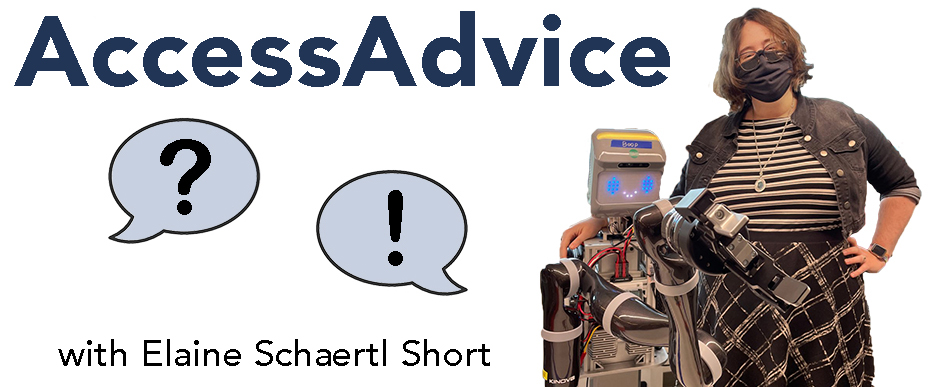
Welcome to “AccessAdvice,” an advice column on accessibility and disability issues written by Elaine Schaertl Short, an AccessComputing co-PI. Before we start, some important disclaimers: everything I say represents only my opinion as an individual, not the opinion of any organization or funder, and I am not a lawyer or medical professional and none of the following should be construed as medical or legal advice. If you’d like to ask a question, email accesscomp@uw.edu with the subject line “AccessAdvice.”
I am about to start a faculty job search; what advice do you have for me? - Job Seeker
Dear Job Seeker,
First of all, congratulations! Even getting to this point is a huge accomplishment: Having a Ph.D. and publication record means that a significant number of senior people in your field have certified that you have something important to contribute – not just your Ph.D. advisor, but also your committee, your postdoc advisor (if you have one), and all of the reviewers and program committee members who have recommended your work for publication. As you prepare to subject yourself to a totally new kind of judgment for what can feel like overwhelming stakes, it can be easy to lose track of how much you’ve done already. I hope you can keep a hold of that thought as you go through the search process; there are no guarantees, but the skills that have brought you to this point will carry you through to good things in the future regardless of how any (or all) of your interviews go.
From a disability perspective, I am not going to lie to you and say that faculty searches are always perfectly fair any more than anything else about the world we live in is fair; there is significant evidence that holding any marginalized identity works against you. That said, my biggest regret from my faculty search was letting ableism and sexism take root in my own head. You may find that it comes in the form of imposter syndrome; in myself, I find it is not that I lack confidence in my own abilities and more that I sometimes despair of ever receiving appropriate credit for those abilities, especially in the case of things like strong leadership and technical expertise that our society says are not characteristic of disabled women. And while these thoughts don’t come from nothing (I have stories, as so many of us do), when you go into your interviews in a mindset of anxiety, apology, or defensiveness, it not only stops you from doing your best or calmly requesting accommodations, it can start to corrode the sense of curiosity, academic freedom, and joy in doing our best work that brings us to academic careers in the first place. While it’s useful to do all the practice and preparation (and clearly in the end it worked, since I did get a faculty job), I wish that I had approached it less from the perspective of anticipating and addressing criticism and more from the perspective of letting my best skills and most interesting ideas shine.
So for your first step, my advice is to get clear for yourself on what you will bring to the table as a faculty member. There are many resources out there on what search committees are looking for; typically it’s a combination of past accomplishments (in most fields, in the form of whatever publications your field most values) and a sense of vision for the future (that will distinguish you from other faculty at the institution and your past mentors). From there, you will have a strong foundation for approaching your search as a two-way process; you are evaluating the department as much as they are evaluating you. In fact, most departments where you interview will be trying to impress you, and most candidates who make it even to the phone interview stage are well-qualified for a faculty position. From this perspective, accommodations become a much easier thing to request; you are giving the department not only the opportunity to live up to their obligations to provide a fair interviewing experience, but also the opportunity to excel in their side of the process. Because of this, while you may have to provide some guidance (which you are probably used to doing at this point in your career, unfair as it is), most departments will jump to accommodate you. In many cases, this is true even if you don’t disclose your disability (or specific condition); when you are making arrangements you can say something like “I will need stair-free routes between locations” or “I will need a 10- or 15-minute break every two hours” and it’s unlikely to be a problem.
In my own search, I explained that I use a cane and have a limited ability to walk long distances but did not specify my disability beyond that (or even that my mobility impairment is a permanent disability rather than a temporary injury). The departments where I interviewed then made sure that my interviews were all in one building (sometimes even in one room) or had someone drive me between meetings and to meals. You might request a translator, additional time between meetings, an additional break of a certain length, someone to meet you at the hotel, that meals accommodate your dietary needs, or that all venues be wheelchair accessible. Your points of contact for this will typically be your host (who is often someone you know or in your field and will be motivated for you to have a good experience) and the department administrators (who are often wonderful and know far more than the faculty about the campus). If you get to your interview and find there is an unexpected barrier (or that a promised accommodation is not available), these are also the people who will help to fix the problem (again, keep in mind that they want to make a good impression even if they don’t make you an offer). At most universities, this combination of advance requests and in-the-moment corrections will be enough to get you through your interview; at the places where this is not the case, you likely would have a miserable experience as a faculty member and you’re better off without them (although I acknowledge that this is easier to say once you have a job).
Once you make it through the interview process, you will find yourself with some number of job offers. If you have interviews but don’t receive any offers, I encourage you to give it at least one more try in the following year; hiring depends on many factors that have nothing to do with your qualifications (such as internal politics around subfields). A different department in a different year is likely to result in a different outcome. Otherwise, if you have at least one offer, you are at the point where you can negotiate. A full overview of the negotiation process is beyond the scope of this article, but as a disabled person you may want to take advantage of this as the time you have the most leverage to get things from both the department and university. While you have the right to accommodations under the ADA, it can sometimes be easier to get exactly the accommodations you want (rather than having to go through the “interactive process”) when they’re written into your startup offer. You might request extra startup funding for converting materials into accessible formats, undergraduate assistants, lab renovations to make your space accessible (for example, my lab and office both have automatic doors), additional course releases, or whatever other support you might need. If you have more than one offer, you are in a particularly strong position; I encourage you to request what you need and take whichever offer provides you with the best opportunities to succeed.
To wrap up, I would love to say that barriers never pop up and that you won’t face rude or thoughtless questions from interviewers; but sadly, it can happen even in well-intentioned departments. If this happens to you I am sorry; it’s unfair and there is a whole community of us working to fix it. I wish you the very best of luck in your search; we need your unique perspective in academia and I would be thrilled to welcome you as a colleague.
-ESS